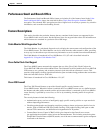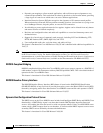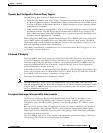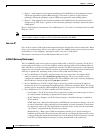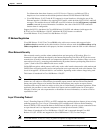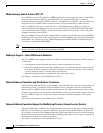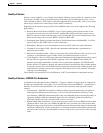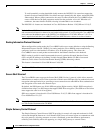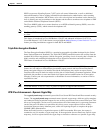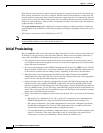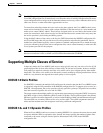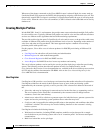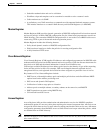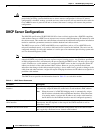
1-13
Cisco uBR924 Software Configuration Guide
OL-0337-05 (8/2002)
Chapter 1 Overview
Cisco IOS Software Release Feature Sets
SGCP can preserve Signaling System 7 (SS7) style call control information, as well as additional
network information, such as routing information and authentication, authorization, and accounting
(AAA) security information. SGCP allows voice calls to be originate and terminate on the Internet, as
well as allowing one end to terminate on the Internet and the other to terminate on a telephone or PBX
on the Public Switched Telephone Network (PSTN).
The Cisco uBR924 cable access router functions as an SGCP residential gateway (RGW), not as the
trunking gateway (TGW), which controls the telephone call.
Note The Cisco uBR924 router supports both H.323 and SGCP call control, but only one method can be active
at a time.
This feature is introduced in Cisco IOS Release 12.0(5)T and enhanced in Release 12.0(7)T. In
Cisco IOS Release 12.1(3)T, this feature is merged with the Media Gateway Control Protocol V12.1.3T
feature, providing simultaneous support for both SGCP and MGCP.
Triple Data Encryption Standard
The Data Encryption Standard (DES) is a standard cryptographic algorithm developed by the United
States National Bureau of Standards. The Triple DES (3DES) standard increases the security from the
standard 56-bit IPsec encryption to 168-bit encryption, providing a level of security that is suitable for
highly sensitive and confidential information such as financial transactions and medical records.
This feature is introduced in Cisco IOS Release 12.0(5)T.
Note Cisco IOS images with strong encryption (including, but not limited to, 168-bit [3DES] data encryption
feature sets) are subject to United States government export controls and have limited distribution.
Strong encryption images to be installed outside the United States may require an export license.
Customer orders may be denied or subject to delay due to United States government regulations. When
applicable, the purchaser or user must obtain local import and use authorizations for all encryption
strengths. Contact your sales representative or distributor for more information, or send an e-mail to
export@cisco.com.
Note Cisco IOS Release 12.1(5)T, 12.2(2), or greater is required to support GRE IP tunnels.
VPN IPsec Enhancement—Dynamic Crypto Map
The crypto dynamic-map command is part of the Cisco Secure PIX firewall and IPsec network security
feature. The crypto dynamic-map command creates dynamic crypto maps, which are policy templates
used when processing negotiation requests for new security associations from a remote IPsec peer. This
allows you to negotiate a session even if you do not know all of the remote peer’s crypto map parameters
(such as the peer’s IP address); in particular, this allows you to accept requests for new security
associations from previously unknown peers, while still requiring the peer to complete the proper
ISAKMP (IKE) authentication.
When the firewall receives a negotiation request via IKE from another IPsec peer, the request is
examined to see if it matches a crypto map entry. If the negotiation does not match any explicit crypto
map entry, it will be rejected unless the crypto map set includes a reference to a dynamic crypto map.



